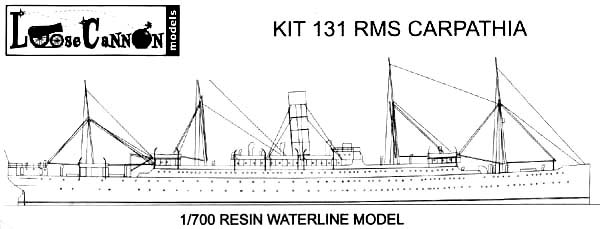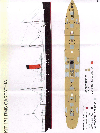
Reviewed by Timothy Dike
February 2013

|
The RMS Carpathia was Cunard Line steamship best known for being the first ship to respond to the Titanic sinking. Built by Swan Hunter & Wigham Richardson Tyne, England in 1902. Carpathia displaced 8,700 t and was 541 ft long and 64 ft 6 in wide. She was launched August 6th, 1902 and made her maiden voyage on May 5, 1903 sailing from Liverpool to Boston. Carpathia operated between New York City, Trieste, Fiume and some Mediterranean ports. She was New York bound from Fiume, Austria-Hungary when her wireless operator, Harold Cottam, picked up the distress signal from the Titanic. Carpathia set course for the Titanic's last know position and arrived 4 hours later picking up 705 survivors who had made it into lifeboats. During World War One, Carpathia became a troopship of the Canadian Expeditionary Force. She transported Canadian and American troops to Europe. She was returning from Livermore from transport duty on July 15th 1918 when she was torpedoed in the Cletic Sea by the German Sub U-55 at 9:15 AM. Hit by two of three torpedoes fired, the ship began to list and settle by the head. The order was given to abandon ship and further attacks were driven off by the HMS Snowdrop, an Azalea-class sloop near by. Five crew members were killed in the initial explosions, but all the 57 passengers, and the remaining 298 crew members safely boarded the lifeboats. Carpathia sank at 11:00 AM at 49.25 N 10.25 W, approximately 120
mi (190 km) west of Fastnet.
|
|||||||||||||
| HULL PARTS | |||||||||||||
| The hull is cast waterline style with nice surface detailing. The hull sides feature nice portholes that all appear to be carefully aligned. The deck features wood plank detail that is pretty fine. The only issues are some mold parting lines along some of the superstructure parts that will need a little attention, but only if you get in close. | Click images
to enlarge |
||||||||||||
|
|||||||||||||
| SUPERSTRUCTURE | |||||||||||||
| Superstructure parts are cast on a thin resin wafer. A little cleanup is needed here, but it will be minimal. The funnel is cast with prominent bands and a hollowed out top. It is cast on a resin block with a slight undercut to make it easier to remove and maintain the correct height. |  |
||||||||||||
|
|||||||||||||
| MASTS | |||||||||||||
| The cargo booms are cast with supporting rods imbedded for strength. There is a bit of flash along the mold parting lines, but a light scraping with an X-acto knife will make short work of it. Having the rod cast in means you don't have fabricate new ones out of brass rod. | |||||||||||||
|
|||||||||||||
| VENTS AND PIPING | |||||||||||||
| A variety of vent tubes are cast on these runners. Most are very well done and there are plenty. | |||||||||||||
|
|||||||||||||
| SHIPS BOATS | |||||||||||||
| Canvas covered boats are cast on resin runners. Instead of being joined to the runner at the keel, they are instead placed upside down. The canvas tops will be easy to clean up since the top is a somewhat random surface as opposed to the delicate keel. |  |
||||||||||||
|
|||||||||||||
| PHOTO ETCH | |||||||||||||
| A brass photo etch fret is supplied with railings, ratlines,
and davits. Rigging, inclined ladders and other details are included. Perhaps
the most important are the etched skylights that can be mounted in open
or shut positions.
A couple lengths of brass rod and a piece of .020 styrene shim are also provided. |
 |
||||||||||||
| DECALS | |||||||||||||
| Decals consist of the ships name for port and starboard, and a curved Carpathia Liverpool for the stern. | |||||||||||||
| INSTRUCTIONS | |||||||||||||
| The instructions are eleven pages with exploded assembly views showing the various sub assemblies. A color painting guide and prototype photos are also included. These are pretty extensive for such a small kit and appear to show all the details. |  |
||||||||||||
|
|||||||||||||
| Conclusions: | |||||||||||||
 Loose
Cannon East has produced yet another cool kit. This one would look equally
at home alongside your Titanic or as part of a WWI convoy. Loose
Cannon East has produced yet another cool kit. This one would look equally
at home alongside your Titanic or as part of a WWI convoy.
This is Kit #131 - 1/700 USS Carpathia listed for $55.00 US, a good price for a complete kit with photo etch fret. Check the Loose Cannon page for details on this and other kits. |
|||||||||||||
